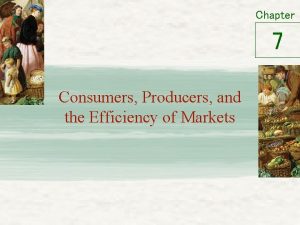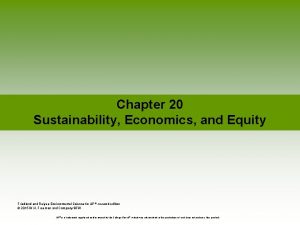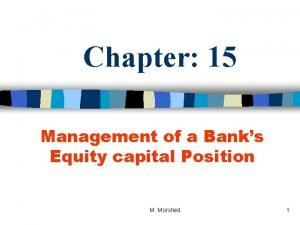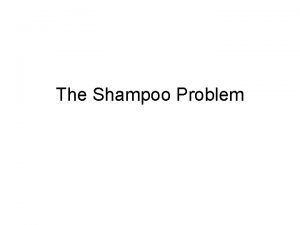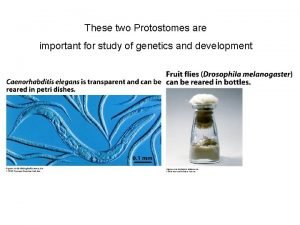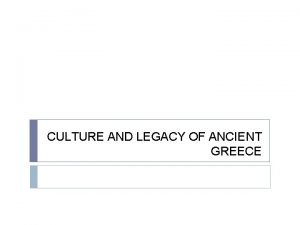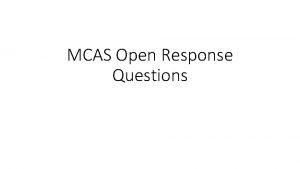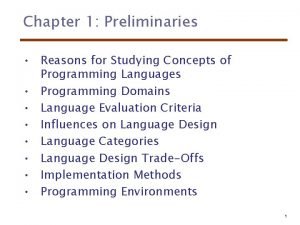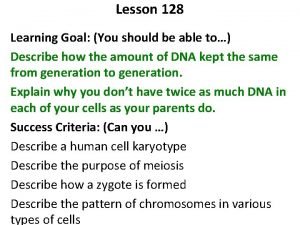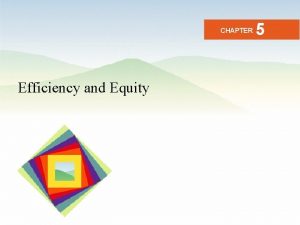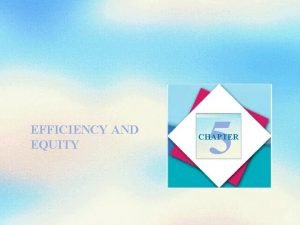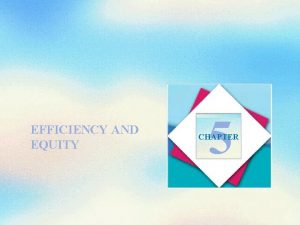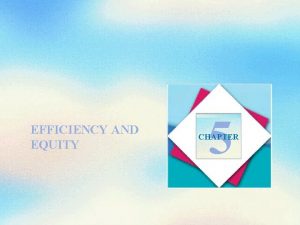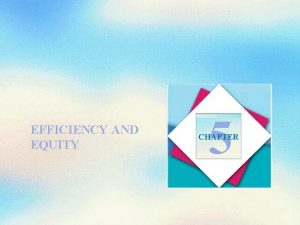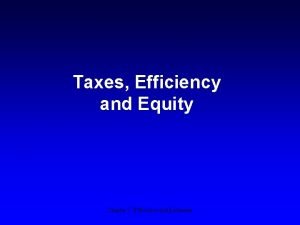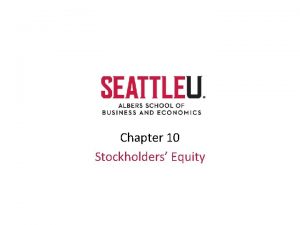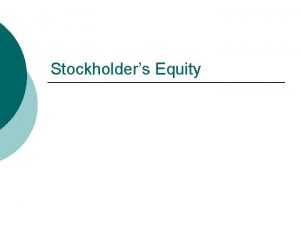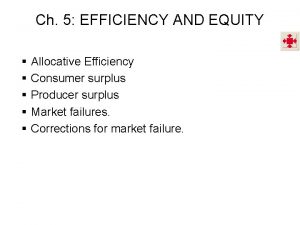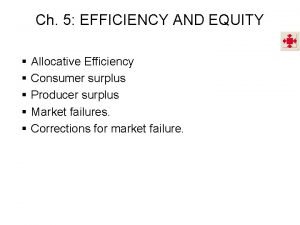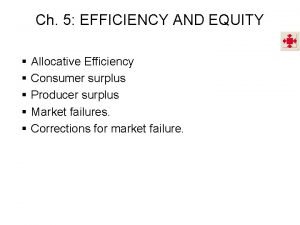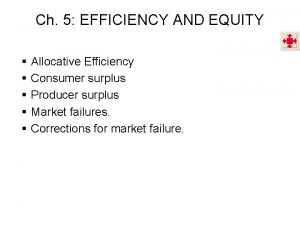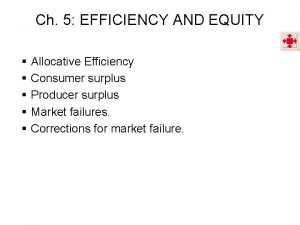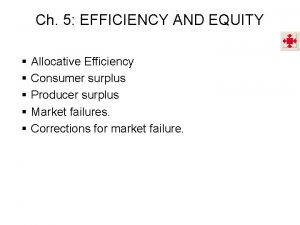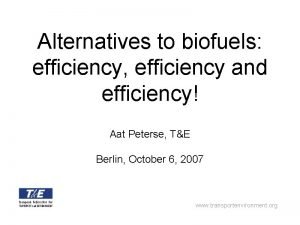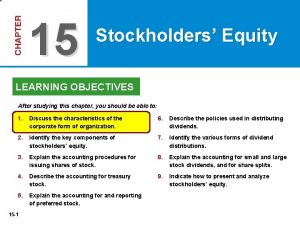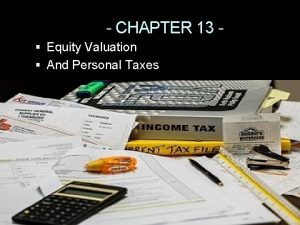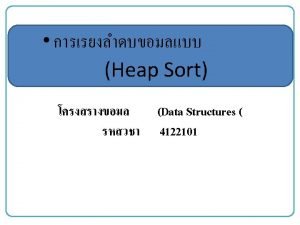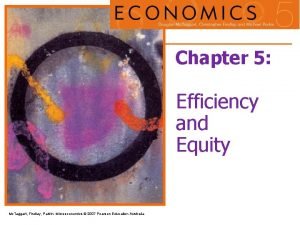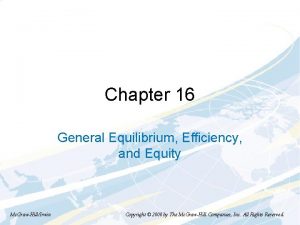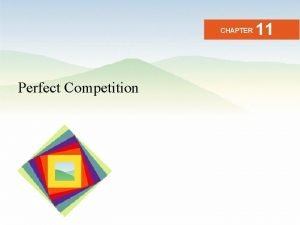5 EFFICIENCY AND EQUITY After studying this chapter


































- Slides: 34


5 EFFICIENCY AND EQUITY

After studying this chapter, you will be able to: ¨ Describe the alternative methods for allocating scarce resources ¨ Explain the connection between demand marginal benefit and define consumer surplus; and explain the connection between supply and marginal cost and define producer surplus ¨ Explain the conditions under which markets are efficient and inefficient ¨ Explain the main ideas about fairness and evaluate claims that markets result in unfair outcomes © 2014 Pearson Education

When you order a pizza, your self-interested choice influences how resources are used. A market coordinates your choice with the self-interested choices of a pizza cook and a delivery person to fill your order. Do markets allocate resources between pizza and everything else efficiently? Markets generate huge income inequality: You can afford to buy a pizza, but it might be an unaffordable luxury for a very poor person. Is this situation fair? © 2014 Pearson Education

Resource Allocation Methods Market Price When a market allocates a scarce resource, the people who get the resource are those who are willing to pay the market price. Most of the scarce resources that you supply get allocated by market price. You sell your labor services in a market, and you buy most of what you consume in markets. For most goods and services, the market turns out to do a good job. © 2014 Pearson Education

Benefit, Cost, and Surplus Demand, Willingness to Pay, and Value is what we get, price is what we pay. The value of one more unit of a good or service is its marginal benefit. We measure value as the maximum price that a person is willing to pay. But willingness to pay determines demand. A demand curve is a marginal benefit curve. © 2014 Pearson Education

Benefit, Cost, and Surplus Individual Demand Market Demand The relationship between the price of a good and the quantity demanded by one person is called individual demand. The relationship between the price of a good and the quantity demanded by all buyers in the market is called market demand. Figure 5. 1 on the next slide shows the connection between individual demand market demand. © 2014 Pearson Education

Benefit, Cost, and Surplus At $1 a slice, the quantity demanded by Lisa is 30 slices and by Nick is 10 slices. The quantity demanded by all buyers in the market is 40 slices. © 2014 Pearson Education

Benefit, Cost, and Surplus Consumer surplus is the excess of the benefit (or value) received from a good over the amount paid for it. Figure 5. 2 on the next slide shows the consumer surplus from pizza when the market price is $1 a slice. © 2014 Pearson Education

Benefit, Cost, and Surplus Lisa and Nick pay the market price, which is $1 a slice. The value Lisa places on the 10 th slice is $2. Lisa’s consumer surplus from the 10 th slice is the value minus the price, which is $1. © 2014 Pearson Education

Benefit, Cost, and Surplus At $1 a slice, Lisa buys 30 slices. So her consumer surplus is the area of the green triangle. © 2014 Pearson Education

Benefit, Cost, and Surplus At $1 a slice, Nick buys 10 slices. So his consumer surplus is the area of the green triangle. © 2014 Pearson Education

Benefit, Cost, and Surplus At $1 a slice, the consumer surplus for the economy is the area under the market demand curve above the market price, summed over the 40 slices bought. © 2014 Pearson Education

Benefit, Cost, and Surplus At $1 a slice, Lisa spends $30, Nick spends $10, and together they spend $40 on pizza. The consumer surplus is the value from pizza in excess of the expenditure on it. © 2014 Pearson Education

Benefit, Cost, and Surplus Supply and Marginal Cost Firms are in business to make a profit. To make a profit, firms must sell their output for a price that is greater than the cost of production. Firms distinguish between cost and price. © 2014 Pearson Education

Benefit, Cost, and Surplus Supply, Cost, and Minimum Supply-Price Cost is what the producer gives up, price is what the producer receives. The cost of one more unit of a good or service is its marginal cost. Marginal cost is the minimum price that a firm is willing to accept. But the minimum supply-price determines supply. A supply curve is a marginal cost curve. © 2014 Pearson Education

Benefit, Cost, and Surplus Individual Supply and Market Supply The relationship between the price of a good and the quantity supplied by one producer is called individual supply. The relationship between the price of a good and the quantity supplied by all producers in the market is called market supply. Figure 5. 3 on the next slide shows the connection between individual supply and market supply. © 2014 Pearson Education

Benefit, Cost, and Surplus Maria and Max are the only producers of pizza. At $15 a pizza, the quantity supplied by Maria is 100 pizzas. © 2014 Pearson Education

Benefit, Cost, and Surplus Maria and Max are the only producers of pizza. At $15 a pizza, the quantity supplied by Max is 50 pizzas. © 2014 Pearson Education

Benefit, Cost, and Surplus At $15 a pizza, the quantity supplied by Maria is 100 pizzas and by Max is 50 pizzas. The quantity supplied by all producers is 150 pizzas. © 2014 Pearson Education

Benefit, Cost, and Surplus The market supply curve is the horizontal sum of the individual supply curves. © 2014 Pearson Education

Benefit, Cost, and Surplus Producer surplus is the excess of the amount received from the sale of a good over the cost of producing it. Figure 5. 4 on the next slide shows the producer surplus from pizza when the market price is $15 a pizza. © 2014 Pearson Education

Benefit, Cost, and Surplus The market price of a pizza is $15. Maria is willing to produce the 50 th pizza for $10. Maria’s producer surplus from the 50 th pizza is the price minus the marginal cost, which is $5. © 2014 Pearson Education

Benefit, Cost, and Surplus At $15 a pizza, Maria sells 100 pizzas. So her producer surplus is the area of the blue triangle. © 2014 Pearson Education

Benefit, Cost, and Surplus At $15 a pizza, Max sells 50 pizzas. So his producer surplus is the area of the blue triangle. © 2014 Pearson Education

Benefit, Cost, and Surplus At $15 a pizza, the producer surplus for the economy is the area under the market price above the market supply curve, summed over the 150 pizzas sold. © 2014 Pearson Education

Benefit, Cost, and Surplus The red areas show the cost of producing the pizzas sold. The producer surplus is the value of the pizza sold in excess of the cost of producing it. © 2014 Pearson Education

Is the Competitive Market Efficient? Efficiency of Competitive Equilibrium Figure 5. 5 shows that a competitive market creates an efficient allocation of resources at equilibrium. In equilibrium, the quantity demanded equals the quantity supplied. © 2014 Pearson Education

Is the Competitive Market Efficient? When production is: § less than the equilibrium quantity, MSB > MSC. § greater than the equilibrium quantity, MSC > MSB. § equal to the equilibrium quantity, MSC = MSB. © 2014 Pearson Education

Is the Competitive Market Efficient? Resources are used efficiently when marginal social benefit equals marginal social cost. When the efficient quantity is produced, total surplus (the sum of consumer surplus and producer surplus) is maximized. © 2014 Pearson Education

Is the Competitive Market Efficient? The Invisible Hand Adam Smith’s “invisible hand” idea in the Wealth of Nations implied that competitive markets send resources to their highest valued use in society. Consumers and producers pursue their own self-interest and interact in markets. Market transactions generate an efficient—highest valued —use of resources. © 2014 Pearson Education

Is the Competitive Market Efficient? Market Failure Markets don’t always achieve an efficient outcome. Market failure arises when a market delivers an inefficient outcome. Market failure can occur because § Too little of an item is produced (underproduction) or § Too much of an item is produced (overproduction). © 2014 Pearson Education

Is the Competitive Market Efficient? Underproduction The efficient quantity is 10, 000 pizzas a day. If production is restricted to 5, 000 pizzas a day, there is underproduction and the quantity is inefficient. A deadweight loss equals the decrease in total surplus—the gray triangle. This loss is a social loss. © 2014 Pearson Education

Is the Competitive Market Efficient? Overproduction Again, the efficient quantity is 10, 000 pizzas a day. If production is expanded to 15, 000 pizzas a day, a deadweight loss arises from overproduction. This loss is a social loss. © 2014 Pearson Education
 After me after me after me
After me after me after me If any man come after me
If any man come after me Allocative efficiency vs productive efficiency
Allocative efficiency vs productive efficiency Allocative efficiency vs productive efficiency
Allocative efficiency vs productive efficiency Productively efficient vs allocatively efficient
Productively efficient vs allocatively efficient Chapter 24 studying the sun
Chapter 24 studying the sun Guided reading lesson 1 studying geography answer key
Guided reading lesson 1 studying geography answer key Studying geography economics and citizenship
Studying geography economics and citizenship Chapter 7 consumers producers and the efficiency of markets
Chapter 7 consumers producers and the efficiency of markets Module 11 studying the brain and older brain structures
Module 11 studying the brain and older brain structures Section 1 studying viruses and prokaryotes
Section 1 studying viruses and prokaryotes Apes chapter 20 sustainability economics and equity
Apes chapter 20 sustainability economics and equity Chapter 15 debt and equity capital
Chapter 15 debt and equity capital Researchers who are studying a new shampoo formula
Researchers who are studying a new shampoo formula Importance of studying population
Importance of studying population Ranking method of job evaluation
Ranking method of job evaluation Dua to say before studying
Dua to say before studying Studying in sweden as an eu citizen
Studying in sweden as an eu citizen Studying our living planet
Studying our living planet A student is studying the ecology of a playa lake
A student is studying the ecology of a playa lake The five i's of studying microorganisms
The five i's of studying microorganisms Section 1 ecologists study relationships
Section 1 ecologists study relationships Juvenile delinquency objectives
Juvenile delinquency objectives Art talk chapter 2 review answers
Art talk chapter 2 review answers Importance of studying protostomes
Importance of studying protostomes Culture or way of living station 1
Culture or way of living station 1 Benefits of studying in a quiet place
Benefits of studying in a quiet place Imagine you are studying english
Imagine you are studying english Uiuc swb
Uiuc swb Kendra is studying the energy pyramid shown
Kendra is studying the energy pyramid shown Prose
Prose Lesson 1 studying geography
Lesson 1 studying geography Reasons for studying concepts of programming languages
Reasons for studying concepts of programming languages Studying
Studying Active recall
Active recall








